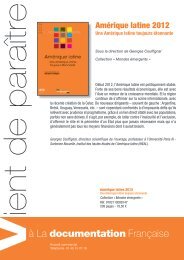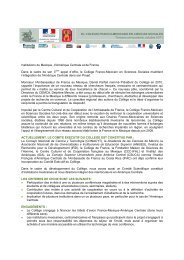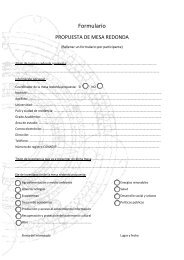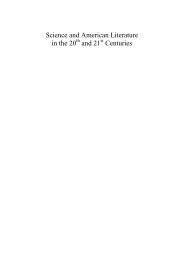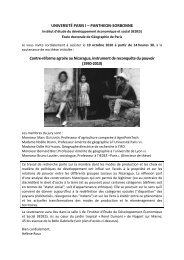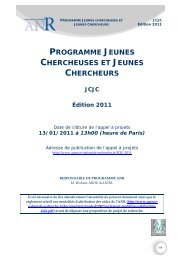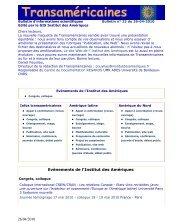Bulletin num. 33 du 25-03-2011 - Institut des Amériques
Bulletin num. 33 du 25-03-2011 - Institut des Amériques
Bulletin num. 33 du 25-03-2011 - Institut des Amériques
Create successful ePaper yourself
Turn your PDF publications into a flip-book with our unique Google optimized e-Paper software.
Transaméricaines88 sur 111 <strong>25</strong>/<strong>03</strong>/<strong>2011</strong> 10:44the "counterculture," which has been glorified in today’s media as a band of rock-singinghippies, had its roots in some of the most provocative social thinking of the postwar!period.Greene chronicles the decade in a thematic manner, devoting indivi<strong>du</strong>al chapters to suchsubjects as the legacy of the fifties, the Kennedy and Johnson administrations, the civilrights movements, and the war in Vietnam. Combining an engrossing narrative withintelligent analysis, America in the Sixties enriches our understanding of that pivotalera.Mots-clés : Etats-Unis ; Kennedy, John F. ; Johnson, Lyndon B. ; Martin Luther King Jr. ;histoire contemporaine ; mouvement d'émancipation ; mouvement de résistance ; droitsciviques ; féminisme ; gouvernement ; guerre ; nationalisme ; transformation sociale ;contre culturehttp://www.syracuseuniversitypress.syr.e<strong>du</strong>/Ouvrage - Karshan, Thomas. Vladimir Nabokov and the Art of Play. Oxford : OxfordUniversity Press, <strong>2011</strong>. 288 p.République Dominicaine -Résumé d'éditeur :In a speech given in December 19<strong>25</strong>, Vladimir Nabokov declared that 'everything in theworld plays', including 'love, nature, the arts, and domestic puns.' All of Nabokov's novelscontain scenes of games: chess, scrabble, cards, football, croquet, tennis, and boxing,the play of light and the play of thought, the play of language, of forms, and of ideas,children's games, cruel games of exploitation, and erotic play.Thomas Karshan argues that play is Nabokov's signature theme, and that Nabokov'snovels form one of the most sophisticated treatments of play ever achieved. He tracesthe idea of art as play back to German aesthetics, and shows how Nabokov's aestheticoutlook was formed by various Russian émigré writers who espoused those aesthetics.Karshan then follows Nabokov's exploration of play as subject and style through hiswhole oeuvre, outlining the relation of play to other important themes such as faith,make-believe, violence, freedom, order, work, Marxism, <strong>des</strong>ire, childhood, art, andscholarship. As he does so, he demonstrates a series of new literary sources, contexts,and parallels for Nabokov's writing, in writers as diverse as Kant, Schiller, Nietzsche,Pushkin, Dostoyevsky, Bely, the Joyce of Finnegans Wake, Pope, and the humanisttradition of the literary game.Drawing in detail on Nabokov's untranslated early essays and poems, and on highlyrestricted archival material, Vladimir Nabokov and the Art of Play provi<strong>des</strong> the fullestscholarly-critical reading of Nabokov to date, and defines the ludic aspect of his workthat has been such a vital example for, and influence on, contemporary writers, fromOrhan Pamuk, W. G. Sebald, and Georges Perec, to John Updike, Martin Amis, and TomStoppard. Through Nabokov, it addresses the literary game-playing that is one of themost distinctive elements in post-1945 literature.Mots-clés : Nabokov, Vladimir ; littérature ; roman ; jeu ; analyse littérairehttp://www.oup.co.uk/Ouvrage - Robitaille-Froi<strong>du</strong>re, Amélie. La Liberté d’expression face au racisme, Etude dedroit comparé franco-américain. Paris : L'Harmattan, <strong>2011</strong>. 298 p.France -Résumé d'éditeur :Une fois énoncée, la liberté d'expression peut être mise en œuvre de manières diverses :la France et les Etats-Unis offrent <strong>des</strong> exemples significatifs <strong>des</strong> deux conceptionsdominantes au sein <strong>des</strong> démocraties modernes. La liberté d'expression doit être conciliéeavec d'autres droits et libertés parmi lesquels le droit à être protégé contre le racisme.Alors qu'en France la prohibition <strong>des</strong> discours raciste et négationniste est largementadmise, seule la provocation raciale est encadrée aux Etats-Unis.Mots-clés : Etats-Unis ; France ; droit comparé ; liberté d'expression ; racisme



